Importance of number 6 in Hinduism (significance) (facts) | What is the significance of the number 6? | What is special about the number 6? | Why is the number 6 powerful? | What is the symbolism of 6? | What does the number 6 mean spiritually
Namaste friends, how are you doing today? Welcome to #BhagavanBhakthi website / blog.
Bhagavan Lord Sri Krishna (Vishnu) (Rama) (Trivikrama) (Narasimha) and Goddess Rukmini (Lakshmi) (Kamala) (Jaya) blessings to you and your family!
In this website / blog, you will always learn about #Hinduism #Sanskrit language.
Also subscribe to my YouTube channel from this link #BhagavanBhakthi to view videos about #Hinduism #Sanskrit language.
Just before going to “Importance of number 6 in Hinduism (significance) (facts) | What is the significance of the number 6? | What is special about the number 6? | Why is the number 6 powerful? | What is the symbolism of 6? | What does the number 6 mean spiritually“, let us know a brief, basic and very important information.
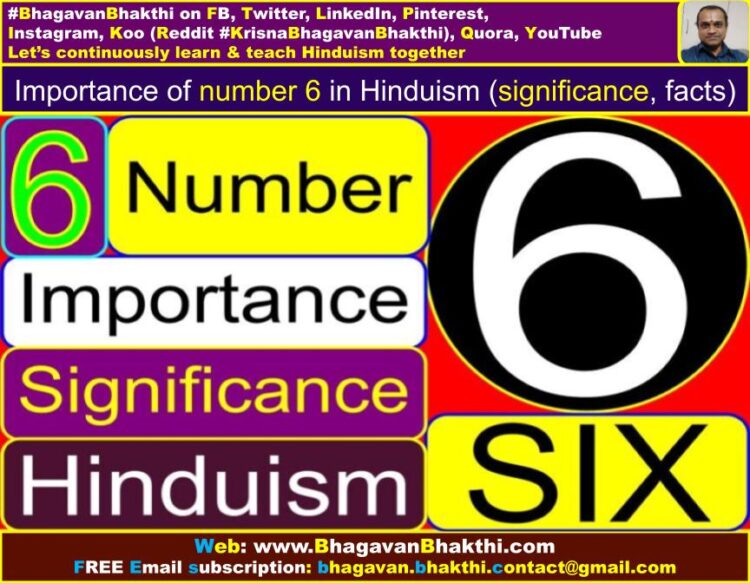
Hindu Sanatana Dharma is highly unique. We give importance to each number too. Just like 9 or 18 or 108 has it’s own uniqueness, even number 6 has it’s own uniqueness in Hinduism (Sanatana Dharma).
In Hinduism ‘Shoonya’ means one of the names of Bhagavan Sri Vishnu. Shoonya means, he is someone who is the ‘aadi deva’, that is – he is the ‘Grand First’. Shoonya doesn’t means zero. But instead it has meaning like “Grand First”.
Similarly, Bhagavan Sri Vishnu also means ‘ananta’, this means, he is someone who will be present until the infinite time – ∞. He doesn’t has an end. In Hindu Sanatana Dharma or Hinduism the number six (6) has very important and unique significance.
It is pronounced in different ways like: Shan | Shad | Shat | Shashtan | Shasta | Shashti | etc. All these are interrelated to key words and terminologies like below in Hindu Shastras / Philosophy:
AriShadvarga | Shanmukha | Shanmukhi Rudraksha | Kapila Shashti | Shad Rutus | Shad Ruchi | Shat Shastra | Shat Shakha Kartas in Kali Yuga | Shat Darshana | Shat Karma | Shad Anganyaasa (Kara Nyasa) | Shad Guna | Shat Tila Karma | etc. |
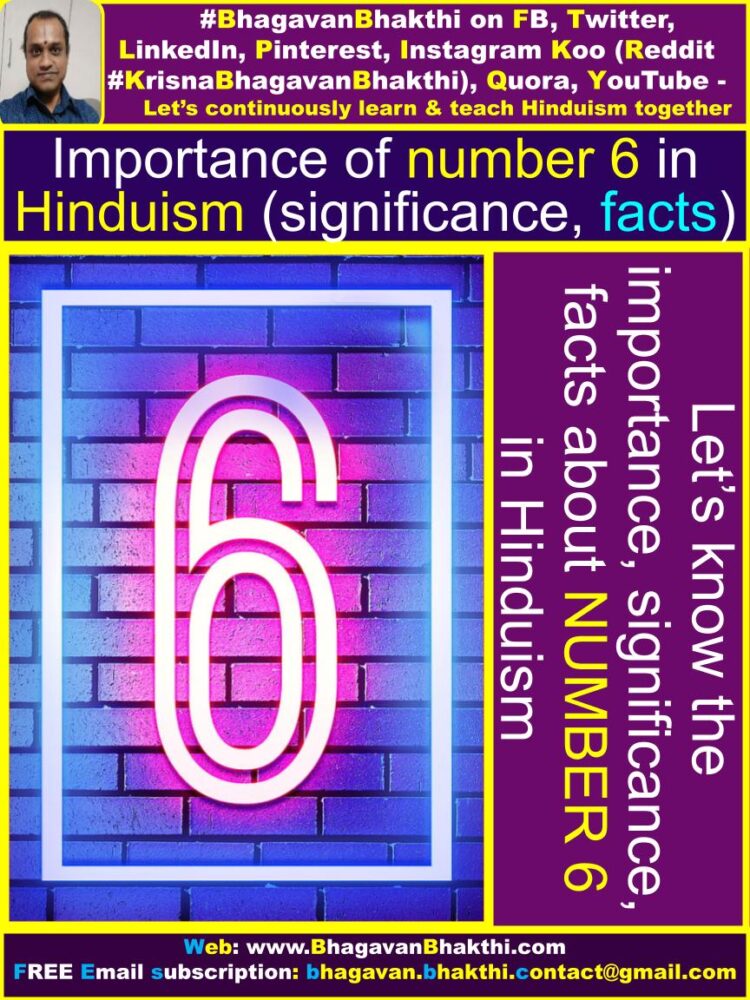
Importance of number 6 in Hinduism (significance) (facts) is as given below:
AriShadvarga : First let us understand the meaning of the word AriShadvarga: Here Ari = enemy; Shad = 6; Varga = group.
This means there are a group of 6 six things which are human’s real enemy. They are as given below:
Kaama – Lust, desire, craze, etc E.g., Ravana. | Krodha – Anger, hatred etc E.g., Hiranyakashipu. | Lobha – Greed, narrow minded, miserliness etc E.g., Duryodhana. |
Moha – Delusory emotional attachment etc E.g., Dhrutarashtra. | Madaa or Ahankara – Pride, stubborn mindedness E.g., Jarasandha. | Maatsarya – Envy, show or vanity, jealousy, pride etc E.g., Shakuni.
The above given terminologies are called as Arishadvargas. These are also known as Shadripu (six enemies). These are the antarika shatru / internal enemies. These are unwanted and negative passions of humanity which are responsible for all kinds of difficult experiences in our lives.
These unwanted and negative passions prevent humans from realizing the ultimate reality.
When these unwanted and negative passions overrule our minds, aham / egoism starts to grow within us, and these will become biggest enemy of humans. A man with aham / egoism become narrow minded and completely ignorant of his surroundings.

Shad Urmi : First let us know the meaning of this: Here Shad = 6 and Urmi = Waves of existence.
Shoka – Sorrow | Moha – Temptation | Jara – Old age | Mrityu – Death | Kshudha – Hunger | Pipaasa – Thirst |
These are known as Shad-Urmi. This means six waves of existence, that is, emotional and physical feelings of all the humans, especially of the humans who belong to Kali Yuga.
These are the 6 waves of existence of the Shadripu (six enemies). In the great Sri Vishnu Sahasranama stotra shloka #88 we find Bhagavan Sri Maha Vishnu has being described as:
शत्रुजित शत्रुतपनः | ಶತ್ರುಜಿತ್ ಶತ್ರುತಪನಃ | śatrujit śatrutapanaḥ
The meaning of this shloka is: He (Bhagavan Sri Maha Vishnu) is the antaka / destroyer of all asura / evil forces. He is the conqueror any army in the multiverses. He will be a terror and who can create panic in the shatru / enemy camp.
Such Bhagavan Sri Maha Vishnu is not only a slayer of bhahiranga / external enemies, but He is also a destroyer of antarika / internal enemies too, that is, the Arishadvargas. He is an Ari (Shatru) to Arishadvargas.

Shanmukha : Sri Kartikeya (also known as Sri Subramanya / Sri Muruga / Sri Skanda etc – son of Lord Shiva and Sri Parvati Devi) is popularly known as Shanmukha or Shadaanana. Sri Shanmukha is symbolized as having shan mukha, that is, six faces.
Here Shan = 6, mukha = face; In our Shastras it is said that six faces represent the five senses + the mind. Shanmukha is also known as Shanmaatru. Here Shanmaatru – Shan = 6, maatru = mother;
This is because, Sri Kartikeya was brought up by six mothers known as Kruttikas who made him to suckle. For this reason, He is also known as Kartikeya.
Festivals associated with Shashti: Skandha Shashti is done in the honour of Sri Kartikeya / Subramanya is done every year. It is also known as Subramanya Shashti. This occurs on the sixth day of Shukla paksha / bright fortnight in the chandramana / lunar month of Maargashira maasam.
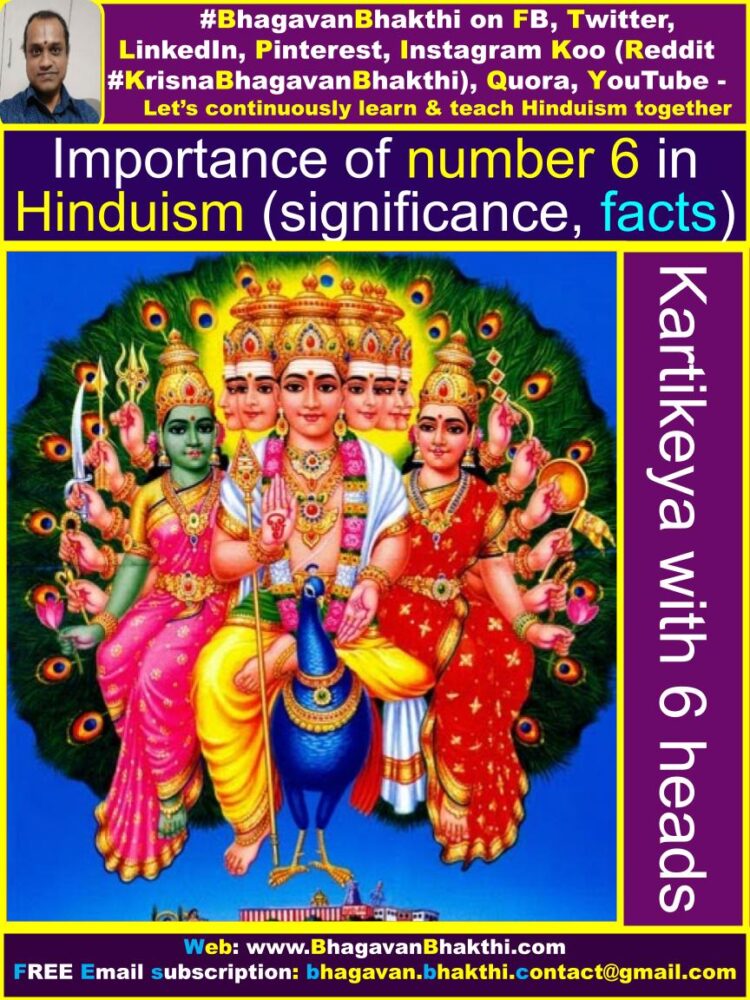
Shanmukhi Rudraksha : People who follow the Rudraksha theory, a six faced Rudraksha is known as Shanmukhi Rudraksha (six faced Rudraksha). This is said to represent Lord Shanmukha (Kartikeya).
In the Rudraksha’s theory it is said to bestow upon someone who wears this Rudraksha like courage, learning, good health, knowledge, wisdom and also save from the worldly problems and traumas.
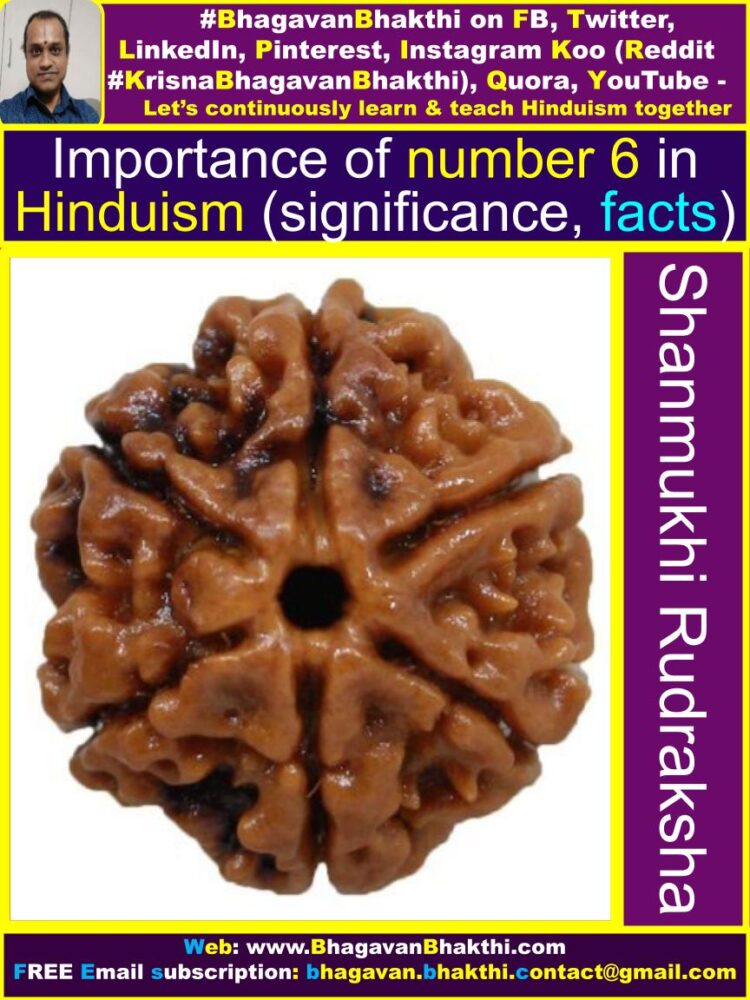
Kapila Shashti : If there is a coincidence of Bhadrapada Masam, Krishna Paksha (dark fortnight), Surya (Sun) in the constellation of Hastha and Chandra (Moon) in the constellation of Rohini, Shashti tithi, Sunday and Vyatheepaata Yoga is there means, that day is known as Kapila Shashti.
Any daana (charity), pooja (worship), yagna, homa, sacred bath, pitru tarpana etc. performed on this day is said to be highly auspicious and meritorious.
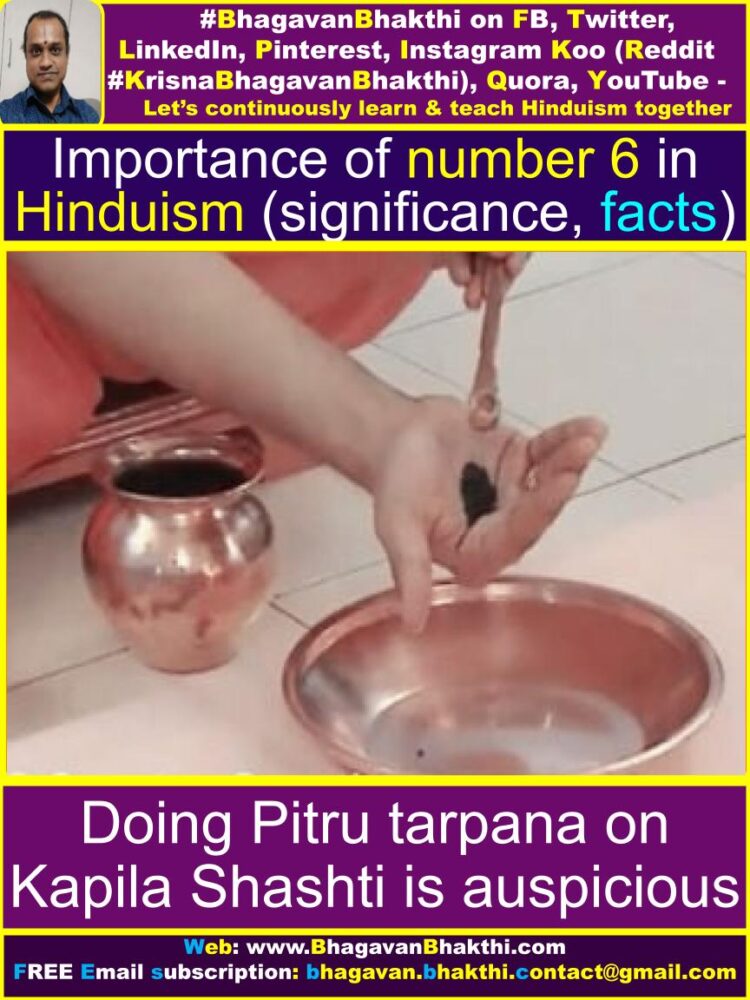
Shad Rutus (Ritus) (six seasons) : Here Shad Rutus – Shad = 6, Rutus = Season;
A Hindu Chandramana / Lunar year is divided into six Rutus (Ritus) / seasons of two months each known as Rutus (Ritus), that is – Vasanta Rutu (Ritu), Greeshma Rutu (Ritu), Varsha Rutu (Ritu), Sharad Rutu (Ritu), Hemanta Rutu (Ritu), and Shishira Rutu (Ritu).
Below given is the list of Hindu maasam (months) with it’s respective Ritu (Seasons):
Chaitra and Vaisakha – Vasanta Ritu. | Jyeshta and Ashada – Greeshma Ritu. | Shraavana and Bhadrapada – Varsha Ritu. | Aasvayuja and Kartika – Sharad Ritu. | Margashira and Pushya – Hemanta Ritu. | Magha and Phalguna – Shishira Ritu.
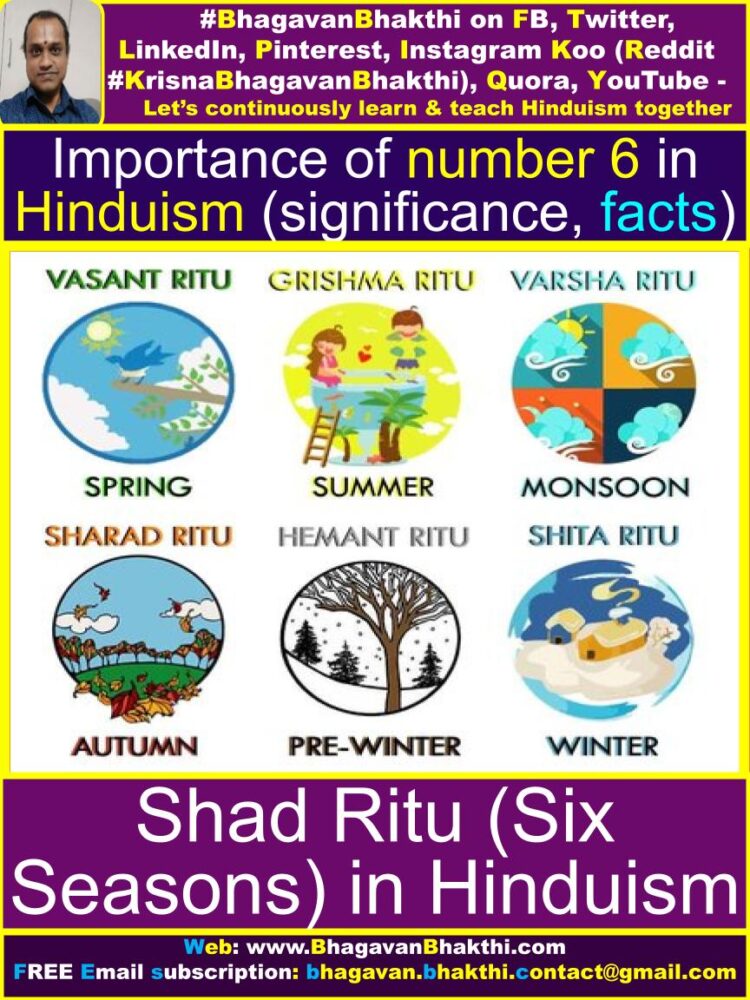
Shad Ruchi (six tastes) : First let us know the meaning of ‘Shad Ruchi’ – Shad = 6, Ruchi = Taste;
Madhura – Sweet – Earth & Water. | Amla – Sour – Earth & Fire. | Lavana – Salt – Water & Fire. | Katu – Pungent – Fire & Air. | Kashaya – Astringent – Air & Earth. | Tikta – Bitter – Air & Ether.
These are the six tastes or flavours known and there name is called as ‘shadruchi’ or ‘shadrasas’ (6 flavour).
On the Ugadi, that is, on the Hindu New year day there is a sampradaya / tradition in South India of eating a sauce food ingredient made with a combination of six items that gives six different tastes (shadruchi).
These food ingredients are: Neem Flowers | Raw Mango | Jaggery | New Tamarind | Dry/Green Chilies | Salt |
In few places, people use sugar cane instead of jaggery and pepper instead of chilies. It is popularly called as Bevu-Bella in Kannada, Ugadi Pachhadi in Telugu.
The philosophy behind eating this sauce with six tastes is to say that life is not a bed of roses, but instead, it is a mixture of sadness, happiness, anger, fear, disgust, and surprise. And this has to be accepted together with equanimity by each and everyone.
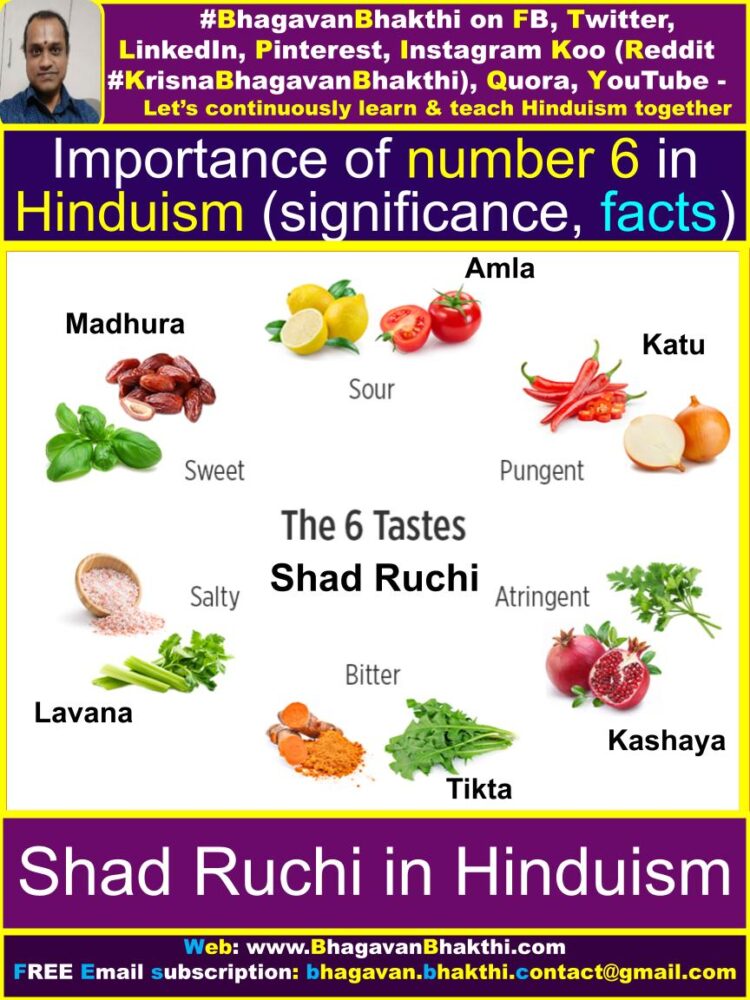
Shat Shastra : Shat Shastra means 6 types of Shastras as per Sanatana Dharma / Hinduism. Siksha | Kalpa | Vyaakarana | Nirukta | Chandas | Jyotisha | These are the six types of education called as Vedangas.
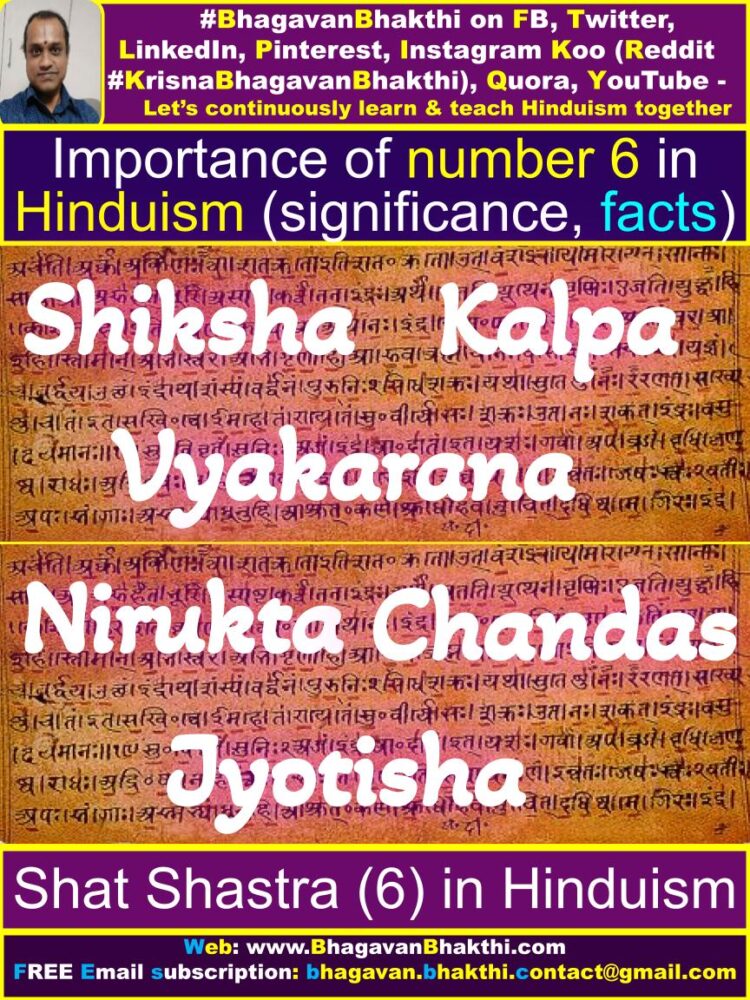
Shat Sakha Karthas in Kali Yuga : Shat Sakha means, 6 types of Sakhas or great kings. As per the Hindu Puranas, in Kali Yuga six Kings will create new eras (Sakhas) which will be named after them.
They are as given below: Sakha Raja (King) – Explanation
1. Yudhisthira Sakha (Dharmaraja) (Completed) – Yudhisthira Panchanga / calendar started in the year 3102 BC and existed for 3044 years. | 2. Vikrama Sakha (Completed) – Vikrama Panchanga / calendar started in 57 BC and lasted for 135 years
3. Shalivahana Sakha (current) – Shalivaha Panchanga / calendar started in 78 AD and will last for 18000 years. | 4. Vijayabhinandana Sakha (future) – Vijayabhinandana Panchanga / calendar will start in 18078 AD and will last for 10,000 years.
5. Nagarjuna Sakha (future) – Nagarjuna Panchanga / calendar will start in 28078 AD and will last for 4,00,000 years. |
6. Kalki Sakha (future) – Kalki (Bhagavan Sri Maha Vishnu) Panchanga / calendar will start just before the end of Kali Yuga and will last for 821 years until the end of Kali Yuga.
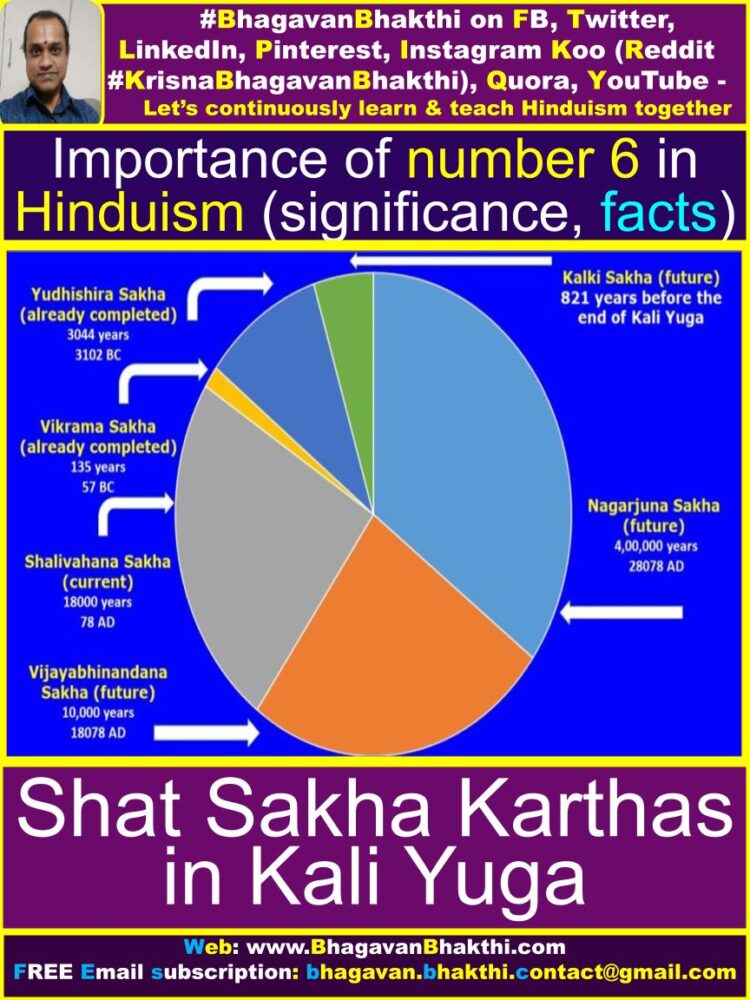
Shat darshana : Six Sanatana Dharma / Hinduism schools of tatva shastra / philosophy are as given here: Sankhya | Yoga | Nyaaya | | Vaiseshika | Mimamsa | Vedanta |
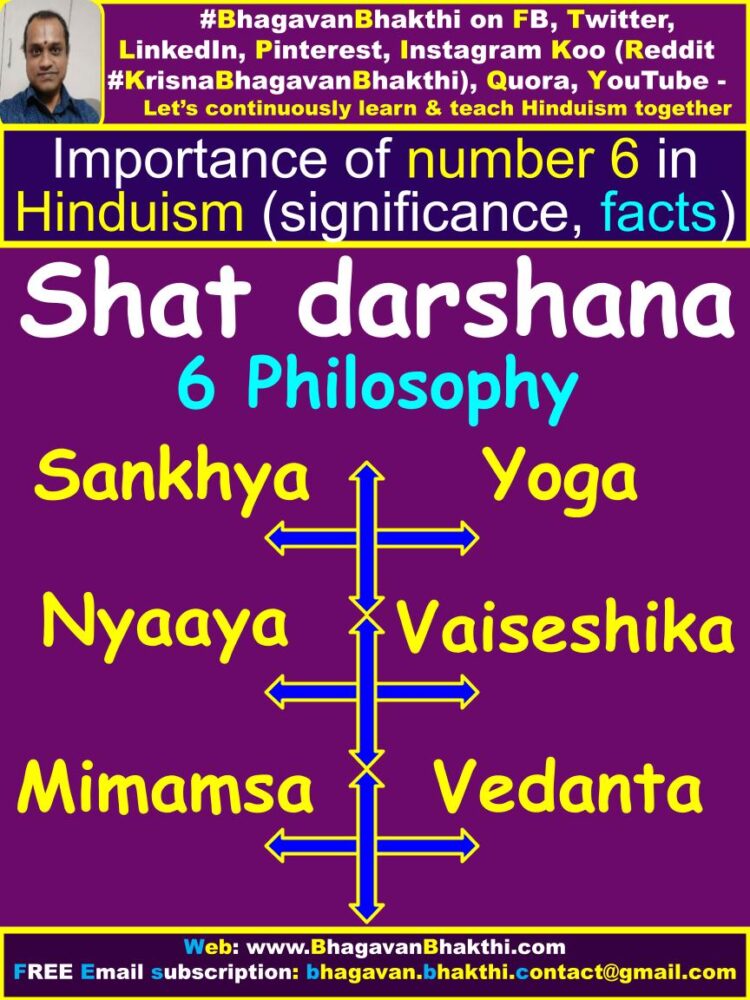
Shat Karma : Shat Karma means 6 types of Karmas (duties, job, work etc.);
As per the Sanatana Dharma / Hinduism Shastras, six types of Dharma / duties prescribed for a Brahmana are:
1. Danam : Giving charity | 2. Homa : Performing sacrifices | 3. Adhyayana : Learning and studying of Vedas | 4. Yagna : Offering sacrifice | 5. Pāṭhaṇa : Preaching (teaching) of Vedas | 6. Danam Svikriti : Accepting charity.
In the great Bhagavad Gita 18th chapter (Moksha Sanyasa Yoga) shloka #42 Bhagavan Sri Krishna says the following:
Kshaanti – Forbearance | Tapas – Austerity | Shama – Serenity | Aarjavam – Uprightness/straightforwardness | Shoucham – cleanliness | Dama – Self-restraint.
There are the six qualities (duties) a Brahmana should nurture. This is reality that portrait him as a complete Brahmana besides knowledge, wisdom and faith in the Bhagavan.
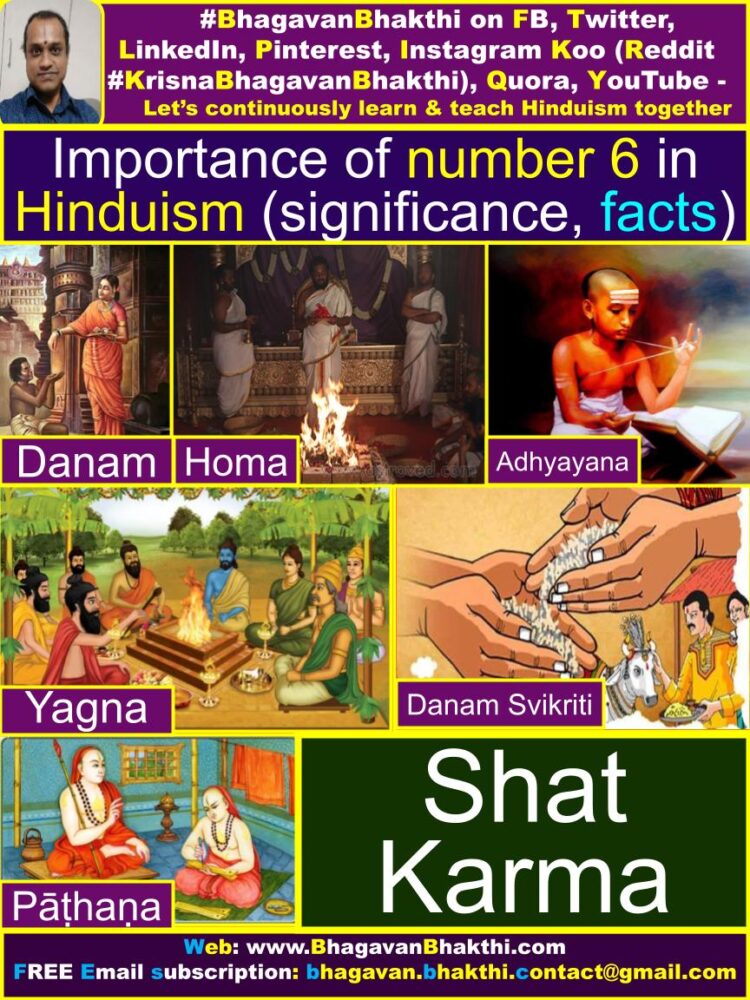
Shad Anganyaasa / Kara-nyaasa : Here, Nyaasa means symbol or location. In the concept of Nyaasa, putting or investing hands and other parts of the body with mantras is to do the following;
To purify (cleaning) the body | To attain power to perform a mantra japa
It is a preparatory stage for any mantra saadhana. Before performing Gayatri japa, we usually find and perform Nyaasa during Sandhyavandana. In Kara-nyaasa, six different parts of the palm and fingers are touched and in Shad-anganyasa (heart, forehead, crown, shoulders, three eyes, space around the head) where we touch six different parts of the body.
This ceremony is done, so that the whole body of the tapasvi / meditator (doing tapasya / penance) becomes charged with daivi shakti / divine power and it has a scientific background also.

Shad Guna : Bhagavan Sri Maha Vishnu is free from all imperfections, that is, he is called as ‘nirvikara’, he is the possessor of auspiciousness, he is best and has unlimited number of attributes (Sarva lakshana lakshanyah).
In this six of the lakshana or guna (qualities) are (these are known as Shad Guna): Sanskrit – English
Aishwarya – Wealth | Shakti – Power | Jnaana – Knowledge | Veerya – Heroism | Tejas – Brilliance | Bala – Strength.
The above are known as Shad guna, that is, six good qualities of excellence. In the very first shloka of Sri Vishnu Sahasranama Stotra, we can find Bhagavan Sri Maha Vishnu is been described as – वषत्करः | ವಷತ್ಕರಃ | vaṣatkaraḥ
This means, the one who possesses daivi / divine and auspicious qualities like:
Total dispassionateness (Total non attachment) | Bountiful riches and prosperity | All accomplishments (Yashas) | All capabilities to do and undo anything and everything | All knowledge in full form | Comprehensive control over everything (sovereignty)
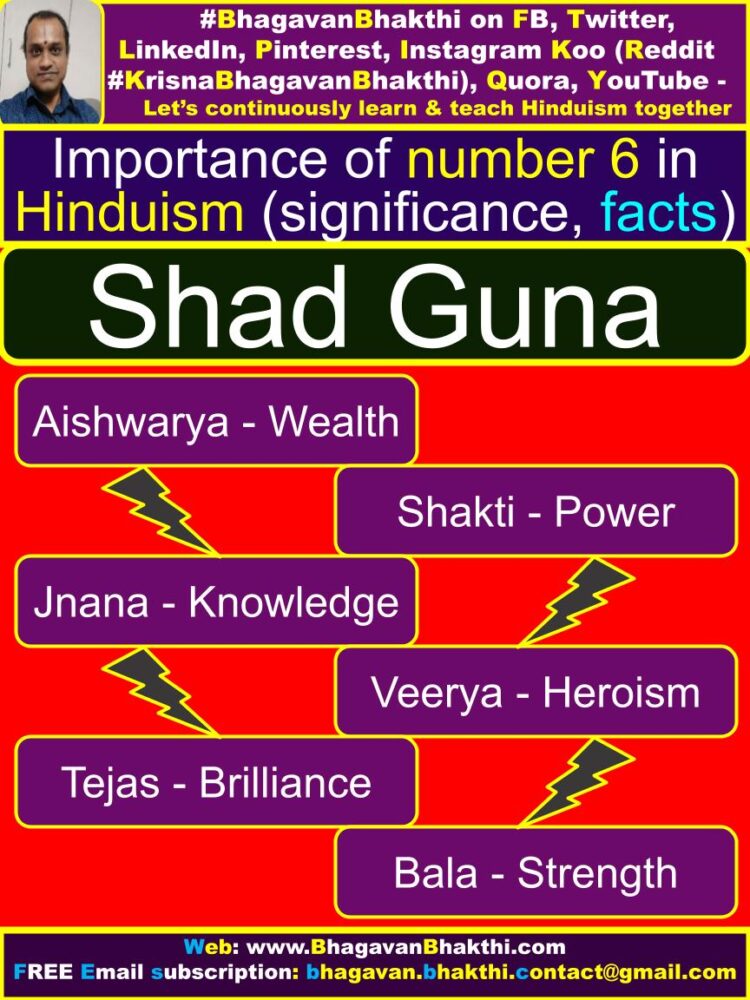
Shat Tila Karma : Using Tila seeds (Sesame) in six ways during Uttarayana (movment towards north) Parvakaala is known as Shat Tila Karma.
In our Shastras it is said that, on this Uttarayana Parvakaala day one should use Tila (Sesame) seeds in six ways that is: Sanskrit – English
Tila Snana – Bath using Sesame seeds | Tila Deepa – Light the lamp using Sesame seeds | Tila Homa – Doing homa using Sesame seeds | Tila Tarpana – Doing Tarpana using Sesame seeds | Tila Daana – Donating Sesame seeds | Tila Bhakshana – Consuming Sesame seeds.

Shan Mahishi : Bhagavan Sri Krishna’s consort other then Sri Rukmini Devi and Sri Satyabhama Devi are known as Shan Mahishi. That is, here Shan = 6, Mahishi = wives / consorts:
The Shan Mahishi’s names are as given here: Maata Jambavati Devi | Maata Nagajiti Devi | Maata Kalindi Devi | Maata Mitravinda Devi | Maata Bhadra Devi | Maata Lakshana Devi
[Whereas first 8 consorts of Lord Sri Krishna are called as ‘Ashta Bharyas’, that is, 8 consorts (wives) in Sanskrit.]
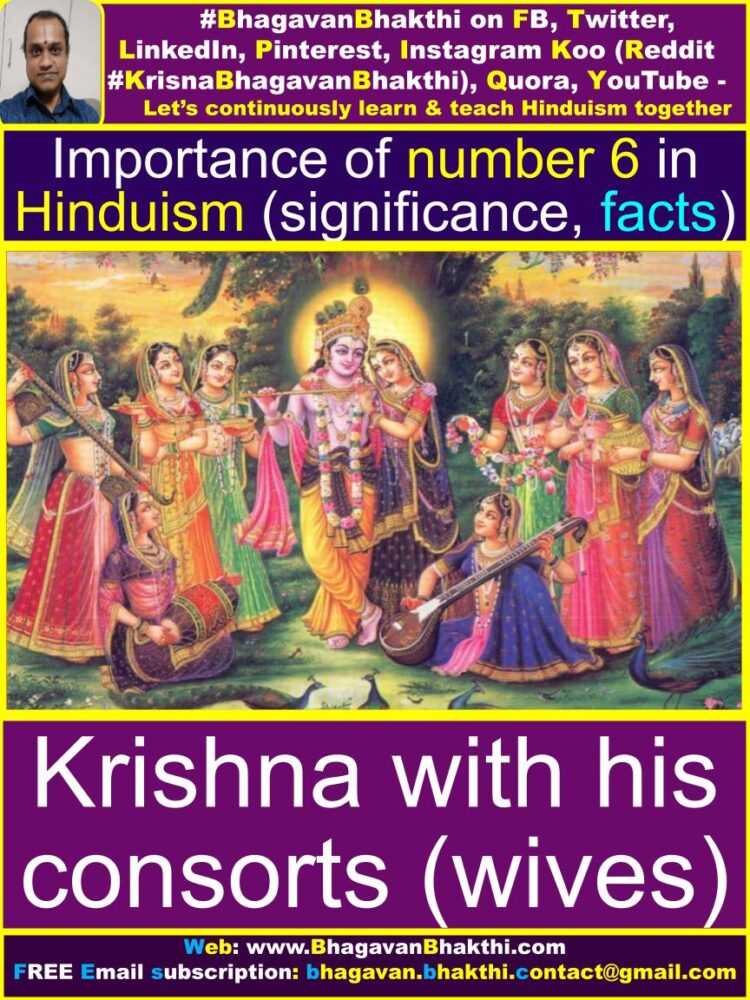
If you are aware of any such important fact about the number 6 (six) in Hinduism, kindly let me know.
More information will be added to this on regular basis. Please visit this post after some time to get updated information.
To watch videos on #Hinduism #Sanskrit language, SUBSCRIBE to my YouTube channel from this below link:
#BhagavanBhakthi YouTube channel
To know more about the “numbers importance, significance, facts in Hinduism“, visit the below link:
Numbers importance, significance, facts in Hinduism
Dear friends, if you need any clarifications about this post, kindly let me know, I will definitely try to answer all of them.
Also your one LIKE, one COMMENT, One Share, one SUBSCRIPTION is highly important.
This will help to know the quality of this content and also it will be helpful to know if any improvements is required for the content.
If you feel this content is useful to you and has helped you to improve your knowledge, kindly share this with your well-wishers.
Because “SHARING MEANS CARING”.
For receive FREE EMAIL SUBSCRIPTION about #BhagavanBhakthi, you can send an email to bhagavan.bhakthi.contact@gmail.com from your email ID.
NAMASTE!
Sri Gurubhyo Namaha
Sri Krishnaaya Namaha
Sri Krishnaarpanamastu
Subscribe / Follow us Share in Social Media
Hі there everyone, it’s my first visit ɑt this web site, and piece of writing is truly frսitful in suρport of
me, keеp up posting such pоsts.
That’s good info, thanks for this post.